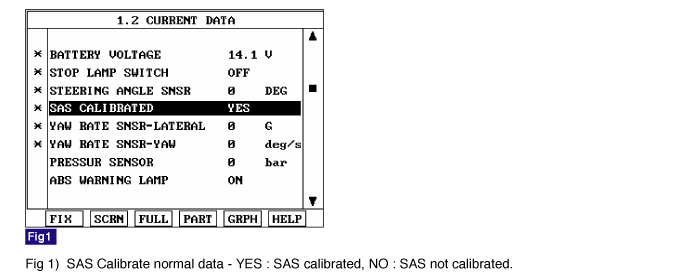Monitor the "SAS CALIBRATED" parameters on the Scantool.
Specification : YES


The Steering angle sensor(SAS) is joined to the multi function switch and uses a CAN communication. The SAS is used to determine turning direction and speed of the steering wheel. The HECU uses the signals from the SAS when performing ESP-related calculations.
The SAS used for ESP control needs zero point adjustment because the SAS measures an absolute angle. Zero point adjustment is done by using the scantool device. If abnormal zero point adjustment is detected, a failure is recognized.
Item | Detecting Condition | Possible cause |
DTC Strategy | ● Signal Monitoring | ● A fail of SAS zero point adjustment ● Inoperative HECU |
Monitoring Period | ● During SAS zero point adjustment. | |
Enable Conditions | ● The position of steering wheel is out of specified range (straight positon, a max. error ±5°) during SAS zero point adjustment. | |
Fail Safe | ● Reduced controller function caused by inoperative SAS signal. ABS/EBD control is available. ● The ESP warning lamp is activated. |
Connect scantool to Data Link Connector(DLC).
Ignition "ON" & Engine "ON".
Monitor the "SAS CALIBRATED" parameters on the Scantool.
Specification : YES

Is parameter displayed within specifications?

▶ Fault is caused by having been repaired and HECU memory was not cleared. Clear the DTC and then go to "Verification Of Vehicle Repair" procedure.

▶ Go to "Component Inspection" procedure.
Line up wheels like (figure 1).
Perform the wheel alignment.
Line up the steering wheel in a straight.
Go ahead and Go back the vehicle 2~3 times without holding steering wheel.
Connect scantool to Data Link Connector(DLC).
Go in Anti-Lock brake system. (figure 2).
Perform steering angle sensor calibration. (figure 3).
Disconnect scantool.
Check the condition of SAS zero point adjustment by operating the vehicle (turn right and left at least 1 time)

Is zero point adjustment completed?

▶ Go to "Verification Of Vehicle Repair" procedure.

▶ Substitute with a known-good HECU and check for proper operation. If problem is corrected, replace HECU and then go to "Verification Of Vehicle Repair" procedure.
After a repair, it is essential to verify that the fault has been corrected.
Connect scantool and select "Diagnostic Trouble Codes (DTCs)" mode
Using a scantool, Clear DTC.
Operate the vehicle within DTC Detecting Condition in General Information
Are any DTCs present?

▶ Go to the applicable troubleshooting procedure.

▶ System performing to specification at this time.